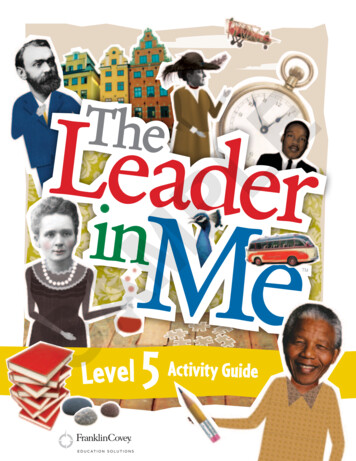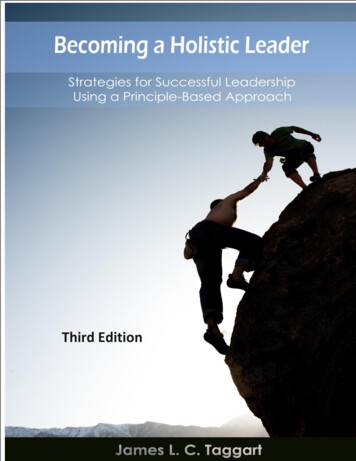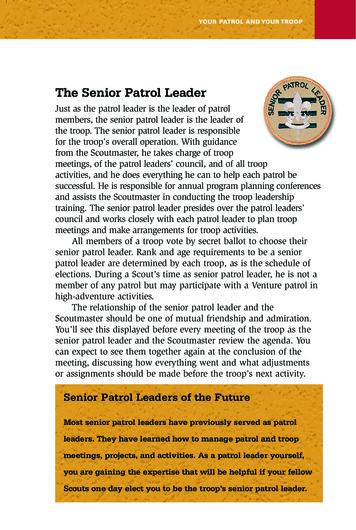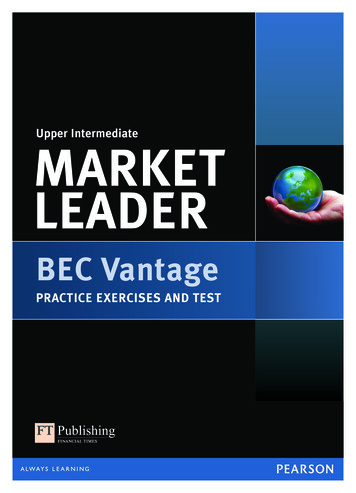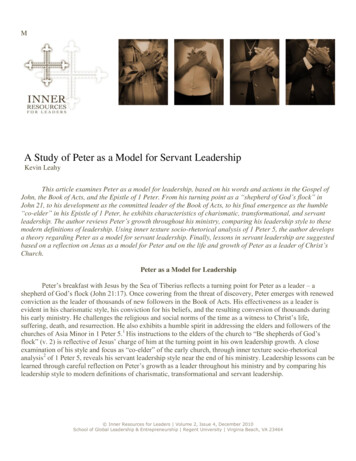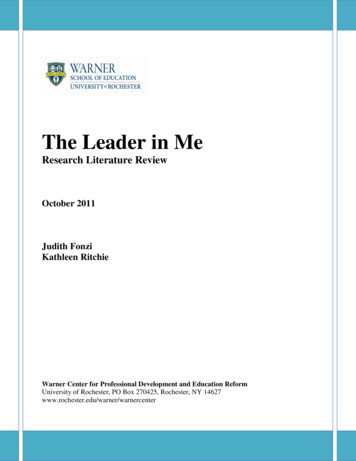
Transcription
The Leader in MeResearch Literature ReviewOctober 2011Judith FonziKathleen RitchieWarner Center for Professional Development and Education ReformUniversity of Rochester, PO Box 270425, Rochester, NY 14627www.rochester.edu/warner/warnercenter
2011, Warner Center, University of RochesterPrefaceThis literature review was undertaken at the request of the FranklinCovey Company. Thepurpose was to determine the extent to which FranklinCovey‗s leadership program for K-12 students,The Leader in Me, aligns with recent research on effective reform strategies and practices. 1 Thisliterature review provides the framework within which The Leader in Me goals, objectives, informingbeliefs, and curriculum design can be examined.A subgroup of the Warner Center Program Evaluation team collaborated on this review toensure inter-reviewer reliability and reduce the impact of reviewer bias. Still, given our commitmentto and extensive experience with K-12 education and reform initiatives, we want to acknowledge thepotential for our interpretation to be influenced by our beliefs. The results articulated here do notrepresent the opinions of FranklinCovey or any of The Leader in Me schools.An examination of the available The Leader in Me documents and artifacts resulted in theidentification of two primary bodies of literature to be mined for this review: 1) research on systemicreform; and, 2) research on social and emotional learning. This report begins with a description ofThe Leader in Me including the beliefs informing the program, and the key design and contentcomponents.The bulk of this report is dedicated to the literature review and presents a detailed account ofthe major research findings related to systemic reform and social and emotional learning. The Leaderin Me is analyzed in light of these findings and the results are reported within each area. This analysisprovides the bases for our conclusions about The Leader in Me’s potential to foster and supportschool transformation and student acquisition of 21st century competencies.The authors of this review have no stake in The Leader In Me program or the outcomes of this literature review.The Warner Center at the University of Rochester was paid a small fee to conduct the review.12
2011, Warner Center, University of Rochester“The Leader in Me is a whole-school transformation model that acts like theoperating system of a computer—it improves performance of all other programs.Based on The 7 Habits of Highly Effective People , The Leader in Me producestransformational results such as higher academic achievement, fewer disciplineproblems, and increased engagement among teachers and parents. Better yet, TheLeader in Me equips students with the self-confidence and skills they need to thrivein the 21st century economy.” The Leader in Me website, FranklinCovey, 2011Description of The Leader in MeAs a result of Principal Muriel Summers‗ effective use of The 7 Habits of Highly EffectivePeople to transform the culture of A. B. Combs public elementary school in North Carolina, theFranklinCovey Company developed The Leader in Me program. This school leadership program isbased on The 7 Habits of Highly Effective People and claims to produce ―transformational resultssuch as higher academic achievement, fewer discipline problems, and increased engagement amongteachers and parents‖ (FranklinCovey, 2011g). The Leader in Me program is a whole schoolleadership model for K-12 schools but has primarily been implemented in elementary schools.The 7 Habits of Highly Effective People (also referred to as the 7 Habits in this report) andthe process for embedding them throughout a school are taught to the adults in the school communityin a three-year professional development program. The adults are expected to embed the 7 Habitsthroughout the entire school program, including instruction in the traditional content areas. As aresult, students are expected to acquire 21st century competencies that are seen as essential forstudents to become successful (FranklinCovey, 2011g).Beliefs Underlying The Leader in MeThe Leader in Me is based on three fundamental beliefs. First, the belief that all individualshave the capacity to lead their own lives. This belief calls for a new paradigm that moves away froma hierarchical model in which titles and positions define leaders to a culture in which all individuals,including students, are given the opportunity to lead. In this new leadership paradigm, StephenCovey calls for looking at leadership through the lens of choice, ―leadership is a choice, not aposition‖ (FranklinCovey, n.d.C, p.29). The Leader in Me promotes this view of leadership andprovides leadership tools to help empower students to see and reach their individual potential. Forexample, students use a data notebook to track their individual progress and expand upon their selfunderstanding to identify and apply their strengths to their personal development (FranklinCovey,2011a).3
2011, Warner Center, University of RochesterThe second fundamental belief underlying The Leader in Me is the belief that the habitsarticulated in The 7 Habits of Highly Effective People pertain to all people regardless of age, race,class, gender or disability (Covey S. R., 2008). And further, that embracing and practicing thesehabits will lead to a transformation of a school‗s content and culture which will result in studentsdeveloping skills such as leadership, accountability, adaptability and problem solving, the 21stcentury competencies that are essential for students to become successful (FranklinCovey, 2011g).The school‗s culture is transformed by fully integrating the habits into its curriculum,traditions, system and culture (FranklinCovey, 2011g). The Leader in Me is not a one shot program itis a process that provides a common language for staff and students at all grade levels, expectsteachers to create and teach daily lessons informed by the habits, and is supported through displayson the school walls and conversations in the classrooms.The third belief informing the program focuses on the diffusion of innovation. In this case theinnovation is the new paradigm of leadership coupled with a practice informed by the 7 Habits.FranklinCovey believes that innovation will be diffused through a ripple effect from teachers andstaff members to the surrounding community, they call this the ―Inside-Out impact‖ (FranklinCovey,n.d.C.). They define leading as ―communicating people‗s worth and potential so clearly that they areinspired to see it in themselves‖ (FranklinCovey, n.d.C, p.30). The job of teachers and administratorsis to encourage and support students in seeking out their leadership ability. Teachers, or staffmembers, tell a student about his/her self-worth and leadership ability and when the student comes tosee this in his/herself, s/he in turn inspires others to see their own worth and leadership abilities,which in turn impacts the culture of the entire school. As a result, the impacts of each individualstudent‗s positive beliefs ripple out into the surrounding community (FranklinCovey, n.d.C).Key Components of The Leader in MeImplementing The Leader in Me is a three year process that builds upon the knowledge andunderstanding of each previous year. This approach was informed by the third principle for creatingand sustaining change articulated in Marzano‗ s 2003 book, What Works in Schools, ―in the new eraof school reform, change is approached on an incremental basis‖ (As cited in Covey S. R., 2008,p.187). FranklinCovey recognizes that no two schools have the same population with the sameachievements and challenges, so there‗s ―no one-size-fits-all process for implementing the leadershiptheme‖ (Covey S. R., 2008, p.166). That said, the year by year foci are the same. The first yearfocuses on introducing the 7 Habits, the second on introducing tools to reinforce the meaning andapplication of the habits, and the third year on renewal training to maximize results. There are two4
2011, Warner Center, University of Rochesterkey components of The Leader in Me program, a 7-day professional development program for theadults in the community and the ubiquitous adoption of the 7 habits by the entire school community.The Leader in Me professional development program begins with a Franklin Covey trainedfacilitator researching the context of the individual school or district to inform the implementation ofthe professional development program. The facilitator gathers available published information andconducts a phone consult with the school leader to gather more in-depth information. Havingknowledge about the school environment, their challenges and issues, and about the individualsattending the training allows the facilitator to anticipate and better prepare for the school‗sprofessional development sessions (FranklinCovey, n.d.C).The core of the professional development takes place in the first year. The curriculum goalsfor these 5 full days of instruction include catalyzing the development of a school vision andparticipants adoption of the 7 Habits in their personal and/or professional lives (FranklinCovey,n.d.C). During the first training days participants clarify their purpose for bringing in The Leader inMe by responding to questions such as: ―What is our vision for our school? What will we dodifferently? What impact could we have?‖ (FranklinCovey, n.d.C, p.72). Answering these questionsgives direction to the program and provides an opportunity for stakeholders to develop ownership ofand buy-in to the process, ―If people see change as something you are doing to them, they mightresist even if it‗s a good thing. But if they see it as something you are doing with them, they are farmore likely to hop on board‖ (Covey S. R., 2008, p.173).Covey describes two different strategies for deciding on a path to arrive at a destination setby the school‗s vision, the hard and soft strategy. The hard strategy is described as ―laying outlogical, orderly, and manageable steps and timetables‖ (Covey S. R., 2008, p.171). In this strategy,priorities and pace are set and needed resources are determined. During the soft strategy process, the―Code of Conduct‖ is worked out. ―The soft strategy is represented by the school‗s values‖ (Covey S.R., 2008, p.171) and are reflected in the character of the school. For example, a school‗s values arereflected in the community‗s response to questions such as, ―How will we treat each other on thejourney? How will we treat the students?‖ (Covey S. R., 2008, p.171).Also during the first days of training, participants are introduced to the 7 Habits and spendtime making sense of their meaning. Participants reflect on their personal and professional lives andidentify contexts in which the habits would be useful. Considerable time is spent in small groupsreading and discussing the habits with the goal of supporting participants to develop shared meaning5
2011, Warner Center, University of Rochesterfor implementing the habits and common language for continuing to discuss them throughout theschool year.The second key component of The Leader in Me program is the ubiquitous integration of the7 Habits of Highly Effective People into the school environment. Muriel Summers found whenspeaking with community members and business owners that they all wanted students who hadcompetencies beyond academic scores (Covey S. R., 2008). They wanted students with leadershipskills who were responsible and could problem solve (FranklinCovey, 2011g). She found that the 7Habits were instrumental in helping students develop these competencies, but only if they wereconsistently drawn upon and applied. As a result, the 7 Habits were re-articulated in student terms forthe Leader in Me program, they are: Be Proactive. This habit focuses on students‘ personal choices and how they have controlover their own actions. Students are taught to take initiative by making statements of ―Ichoose my actions, attitudes, and moods. I do not blame others for my wrong actions. Ido the right thing without being asked, even when no one is looking‖ (Covey S. R.,2008,p.21). Begin with the End in Mind. This habit focuses on thinking about the end result. Studentsare encouraged to plan ahead and set goals. Personal statements include: ―I am animportant part of my classroom and contribute to my school‗s mission and vision, andlook for ways to be a good citizen‖ (Covey S. R., 2008, p.21). The Leader in Me datanotebooks are used to support this habit, as they allow students to track personal andacademic goals, and provide them an opportunity to see where their current achievementis compared to their goals (Covey S. R., 2008). Put First Things First. This habit encourages students to prioritize so that they may spendtime on things that are most important first. Student statements would include: ―I spendmy time on things that are most important. This means I say no to things I know I shouldnot do. I set priorities, make a schedule, and follow my plan. I am disciplined andorganized‖ (Covey S. R., 2008, p.21). Think Win-Win. Students say, ―I balance courage for getting what I want withconsideration for what others want When conflicts arise, I look for third alternatives‖(S.R., 2008, p.21). Through this process, students learn to recognize how they react canaffect others.6
2011, Warner Center, University of Rochester Seek First to Understand, Then be Understood. Students are encouraged to see thingsfrom another‗s point of view by listening to others‘ ideas and feelings. Students wouldsay, ―I try to see things from their viewpoints I am confident in voicing my ideas‖(Covey S. R., 2008, p.21). Synergize. The goal of this habit is to focus on working well with groups and gettingalong with others. Students state: ―I seek out other people‗s ideas to solve problemsbecause I know that by teaming with others we can create better solutions than any one ofus can alone‖ (Covey S. R., 2008, p.22). By working in groups, students learn to valueothers‘ differences. Sharpen the Saw. This habit puts the focus back on the individual and the importance oftaking care of oneself. Students say: ―I learn in lots of ways and lots of places, not just atschool. I take time to find meaningful ways to help others‖ (Covey S. R., 2008, p.22).This habit focuses on eating right, exercising, and spending time with friends and family.The Leader in Me calls for a ubiquitous approach embedding the 7 Habits in school‗scurriculum, traditions, systems and culture. The purpose is to reinforce a unified message to studentsand to allow for flexibility in how a school or teacher actually implements the habits. The followingexample from a teacher at A. B. Combs Elementary School provides a good example of the extent towhich teachers have autonomy in when and how they include the habits in their classroominstruction.As a part of literature and writing module, she had fifth-grade students dissect the LangstonHughes poem ―I Dream a World,‖ which shares his vision for a better world. After discussingthe poem‘s vocabulary, structure, and meaning, Mrs. Barnett divided students into teams andassigned each member a leadership role, such as scribe, timekeeper, or spokesperson. Shethen gave each team a poster-sized sheet of paper and challenged them to select one qualitytool to illustrate the main points of the poem. One team chose to use a lotus diagram, anothera bone diagram, two others a Venn diagram Upon completion, each spokespersonpresented her or his team‗s creation. As a class, they then discussed which of the 7 Habitswere evident in the poem, after which they were given personal writing assignments todescribe what type of vision and dreams they had for their lives in the days ahead (Covey S.R., 2008, p.53-54).The lesson appears to only be asking students to recognize evidence of the 7 Habits, howeverit was simultaneously engaging them in using the 7 Habits. Notice that the students were put ingroups so they had to work together, they had to identify a quality tool that would best accomplishthe end goals, they had to take leadership roles in presenting their work to others. The lesson wasonly 30 minutes, but was able to incorporate several elements of The Leader in Me (Covey S. R,7
2011, Warner Center, University of Rochester2008). Any school day may offer numerous opportunities for highlighting and practicing the 7 Habitsand teachers are encouraged to take up these opportunities in whatever way they choose. The Leaderin Me professional development program is completely designed and articulated for the facilitatorsbut if, and how, the school community actually takes up the challenge to build a new culture in theirschool is completely controlled by the school community.Review of Relevant LiteratureTo inform this review of the literature, we read and analyzed the book, The Leader in Me(Covey S. R., 2008), The Leader in Me Facilitator Guides provided to us by FranklinCovey, and TheLeader in Me website. Drawing on our knowledge of and experience with education reform, twocentral concepts emerged as central in the conceptual design of The Leader in Me program—systemic reform and social and emotional learning.Systemic reform takes the position that whole organizations or educational institutions arereformable, complex systems. The Leader in Me claims to transform the culture of a school through aprocess that involves all stakeholders and a ubiquitous implementation of a new leadership paradigmthus implying a belief that the whole system can be reformed. In addition, The Leader in Me protocolfor implementation requires facilitators to develop an understanding of the school context, thestakeholders‘ involvement, and the participants in order to support the community in creating avision for their new culture. Such attention to the individuality of schools and districts suggests abelief in the complexity of these systems. Social and emotional learning focuses on the creation andenhancement of positive behavioral traits linked with success inside and outside of a classroomsetting (CASEL, 2006; Durlak, Weissberg, Dymnicki, Taylor, & Schellinger, 2011; Elias, et al.,1997; Kress, Norris, Schoenholz, Elias, & Seigle, 2004; Norris & Kress, 2000; Payton, et al., 2008;Rogers, 2003; Sparks, 2011; Weissberg & O'Brien, 2004; Zins, Weissberg, Wang, & Walberg,2004). The Leader in Me seeks to teach and support the adoption of new behavioral beliefs andpractices for all students. When we combine this fact and the results claimed by FranklinCovey andsome participants in the The Leader in Me program there are compelling similarities to thoseidentified in research studies of social and emotion learning programs. Hence, this review focuses onthe current research in systemic reform and social and emotional learning.Once the central conceptual design concepts were identified, a review of the systemic reformand social and emotional learning literature was conducted. Each potential text was examined andkept or discarded through a three-step process. First, it was reviewed to determine its relevance to our8
2011, Warner Center, University of Rochestertask: Did the text go into detail about the concept or the design of a program informed by theconcept? Next the text was evaluated on the basis of its credibility: Did the text describe reputableresearch in the field? What is the author‗s reputation in the field? What sources are being cited?Finally, the specific content of the text was examined in detail to develop an understanding of thespecific contributions it made to the field, and to determine the implications for the success of theprograms with similar goals.Review of the Literature on Systemic ReformThe definition of systemic reform varies based on the source. Generally, all of the literaturereviewed for this report discussed systemic reform as a broad change of interrelated components of asystem, e.g., classrooms, departments, schools, districts, states, students, parents, community,teachers, and administrators. More specifically, Carr-Chellman (1998) found that 84% of booksended up referring to systemic change as a change within the current system as opposed to only twopercent referring to it as a whole new system (p.381). Anderson, Brown, and Lopez-Ferrao (2003)define systemic reform as a ―complex, long term process that requires simultaneous changes‖ (p.619). The Leader in Me program reflects both of these definitions as it is intended to progressivelychange a current system over three years, through the inclusion of all of the constituencies within aschool, and to impact the culture and practices of the community.Systemic reform is a ―continuous process in which we create and design in order to comecloser and closer (though never quite attaining) the ultimate goal of an ideal vision of education andlearning‖ (Carr-Chellman, 1998, p.373). It requires individuals to be willing and open to consistentlyreevaluate the current system in which they work through reflection and communication with allstakeholders (Jenlink, Reigeluth, Carr, & Nelson, 1998). Ideally, it is finding a balance ―betweensustaining the best current practices and exploring new ideas ‖ (Anderson, Brown, & Lopez-Ferrao,2003, p.624). When it comes to systemic reform, the question that needs to be asked is, ―How can wedesign a system that will continuously reform (i.e. renew) itself, beginning with presently specifiableills and moving on to ills that we cannot now foresee?‖ (J.W. Gardner as cited in Carr-Chellman,1998, p.372)Table 1 provides a brief explanation of key factors drawn from the research of successfulsystemic reform programs and how they compare to The Leader in Me program. Following the table,each factor and the comparison is discussed in detail.9
2011, Warner Center, University of RochesterTable 1: Key Factors Drawn from the Research on Systemic Reform and a Comparison to TheLeader in Me PracticesKey Factors1. Timeframe22. Facilitator3Systemic Reform (SR)Lengthy process, dependent oncontextual factorsMinimum three-year processCan be internal or external; mustbe knowledgeable and skilledUses a FranklinCovey trainedfacilitatorChange is context dependentRequires facilitators to begindeveloping an understanding ofthe school context whileplanning; leaves the details ofhow to implement in the schoolto the school communityEncourages client to include allstakeholders3. Contextual Understanding44. Stakeholder Involvement5The Leader in Me (TLIM)Universal process; allstakeholders must be includedHaving a vision is crucialTeaches participants how todevelop a vision6. Core Teams7Smaller group within a contextlead the effort7. Teachers at the Center8Pivotal due to direct daily contactwith studentsCreates a school LighthouseTeam (6 people in the schoolcommunity) to shepherd andoversee implementationDefines ―Inside-Out‖ theory –first work with teachers, thenstudents, and then parents;provides an online space forteachers to communicate withinand across sitesInformally solicits schoolnarratives; changes in such thingsas disciplinary referrals, studentsachievement, & parentinvolvement5. Vision68. Evaluation9Formal evaluation plansincluding ongoing feedback,observations, & achievementresults2 SR:Anderson, Brown, & Lopez-Ferrao, 2003; Carr-Chellman, 1998; Jenlink, Reigeluth, Carr, & Nelson, 1998.TLIM: Covey S.R., 2008; FranklinCovey, n.d.C3 SR: Fullan, Hill, & Crevola, 2006; Jenlink, Reigeluth, Carr, & Nelson, 1998. TLIM: FranklinCovey, n.d.C4 SR: Jenlink, Reigeluth, Carr, & Nelson, 1998. TLIM: FranklinCovey, n.d.C5 SR: Anderson, Brown, & Lopez-Ferrao, 2003; Fullan, Hill, & Crevola, 2006; Jenlink, Reigeluth, Carr, & Nelson,1998. TLIM: Covey S. R., 2008; FranklinCovey, n.d.C6 SR: Anderson, Brown, & Lopez-Ferrao, 2003. TLIM: Covey S. R., 2008; FranklinCovey, n.d.C7 SR: Jenlink, Reigeluth, Carr, & Nelson, 1998; Pasi, 2001. TLIM: FranklinCovey, n.d.B8 SR: Lieberman & Miller, 1999. TLIM: FranklinCovey,. n.d.C; FranklinCovey, 2011a; FranklinCovey, 2011b;FranklinCovey, 2011d9 SR: Abbott, O'Donnell, Hawkins, Hill, Kosterman, & Catalano, 1998; Friel & Bright, 1997; Little, 1993. TLIM:Covey S. R., 2008; FranklinCovey, 2011f10
2011, Warner Center, University of RochesterTimeframe. Research suggests that the timeframe of and process for systemic reform can belong, intense, slow, and frustrating, with some literature proposing more than five years to complete(Jenlink et al., 1998; Anderson, Brown, & Lopez-Ferrao, 2003; Little, 1993). The process is longbecause it requires multiple changes in policy, curriculum and/or structure (Anderson, Brown, &Lopez-Ferrao, 2003; Rogers, 2003). Stakeholders may feel a sense of urgency but Lieberman andMiller (1999) ―caution against overlooking the importance of process‖ (p.60). The reviewed researchdoes not articulate a timeframe. The timeframe depends on several factors including, but not limitedto, the operating definition of systemic reform, size of the population to be effected, process forimplementation, amount and nature of resistance, and definition of success.The Leader in Me is a three year professional development program for adults in the schoolcommunity. Each year focuses on a different element of the process. Year one is titled ―Establishinga Culture of Leadership‖ (FranklinCovey, 2011a) and focuses on developing the foundation for aculture of leadership. During the first year the adults are introduced to the 7 Habits and theimportance of creating visions for guiding their work. It is assumed that teachers will begin to infusethe habits into their instructional practices during this year. The second year, ―Applying Tools ofLeadership,‖ builds upon the learning that took place the first year and introduces tools such as thedata notebooks to support continued growth (FranklinCovey, 2011a). The third year, and anysubsequent years, focus on ―Maximizing Results‖ as the school community begins to customize theirapproach to ensure achievement of their vision and maintain momentum (FranklinCovey, 2011a).Facilitator. Fullan, Hill, and Crevola (2006) suggest that who facilitates the professionaldevelopment may be less important than having strong leadership involvement and appropriatesystems put in place to shepherd and support the change (discussed in more detail under Core Team).The facilitator may come from within or outside the system to be changed. What is important is thatthe facilitator has the knowledge and skills to conduct an intensive, long term change effort, and isseen as fair or neutral by all stakeholders, so there is no sense of favoritism (Jenlink et al., 1998).Schools purchase The Leader in Me from FranklinCovey Education. The purchase includesprofessional development implemented by FranklinCovey trained facilitators, participant materialsincluding The Leader in Me and The 7 Habits of Highly Effective People books, materials for use byteachers and schools, and access to a teacher social media network. The facilitators are expected touse the facilitator guides when providing the professional development (FranklinCovey, n.d.A;FranklinCovey, n.d.B; FranklinCovey, n.d.C). The guides state, ―This is a facilitator-assistedtraining. Training must be conducted by facilitators who have been certified by FranklinCovey‖(FranklinCovey, n.d.C, p.2).11
2011, Warner Center, University of RochesterContextual understanding. Understanding the context and environment within which thereform is to take place is vital (Anderson, Brown, & Lopez-Ferrao, 2003; Friel & Bright, 1997;Jenlink et al., 1998; Little, 1993) because ―systemic change is context dependent‖ (Jenlink et al.,1998,p.220) and learning is influenced by the context in which it takes place (National ResearchCouncil, 2000). In order to set goals and measure progress, one must know the schools‘ current statuson the parameters of focus. The level of communication, degree of support, current state of theschool and even the values modeled by district leaders can also impact the outcomes of a changeinitiative (Lieberman & Miller, 1999). Thus, it is crucial that facilitators of change—whether withinor outside the system—be aware of the site‗s climate, culture, demographics, history, participants‗perceptions of the current state of the school, and short and long term expectations. Facilitators fromoutside the system need to begin their work by developing a relationship with the site. All facilitatorsneed to interview the varied stakeholder groups and observe the day-to-day operations at the site toacquire an understanding of the context from multiple points of view. Understanding the contextallows the facilitator to tailor the program design and uncover potential areas for resistance (CarrChellman, 1998; Jenlink et al., 1998).According to The Leader in Me Facilitator Guides, prior to the beginning of the professionaldevelopment program facilitators must gather information about a school‗s context using a requiredprotocol. Facilitators must examine the school‗s website and solicit from school personnelinformation about their background and experience with their school, what they feel are the strengthsof their school, and what challenges they, their students, staff and/or parents face (FranklinCovey,n.d.B; FranklinCovey, n.d.C). The subsequent implementation of The Leader in Me and itsprofessional development program is informed by what the facilitator learns. The professionaldevelopment goals and design are predetermined but the facilitator makes instructional decisions inlight of the context.Stakeholder involvement. When stakeholders become involved there is a greater level oftrust created (Fullan, 2003). In their study of 100 schools in Chicago Bryk and Schneider found that―Schools reporting strong positive trust levels in 1994 were three times more likely to be categorizedeventually as improving in reading and mathematics ‖ (As cited in Fullan, 2003, p. 42). Likewise,Leibe
In this new leadership paradigm, Stephen Covey calls for looking at leadership through the lens of choice, ―leadership is a choice, not a position‖ (FranklinCovey, n.d.C, p.29). The Leader in Me promotes this view of leadership and provides leadership tools to help empower



